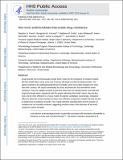Nontoxic antimicrobials that evade drug resistance
Author(s)
Davis, Stephen A; Endo, Matthew M; Whitesell, Luke; Marchillo, Karen; Andes, David R; Burke, Martin D; Vincent, Benjamin Matteson; Lindquist, Susan; ... Show more Show less
DownloadLindquist_Non-toxic antimicrobials.pdf (878.2Kb)
PUBLISHER_POLICY
Publisher Policy
Article is made available in accordance with the publisher's policy and may be subject to US copyright law. Please refer to the publisher's site for terms of use.
Terms of use
Metadata
Show full item recordAbstract
Drugs that act more promiscuously provide fewer routes for the emergence of resistant mutants. This benefit, however, often comes at the cost of serious off-target and dose-limiting toxicities. The classic example is the antifungal amphotericin B (AmB), which has evaded resistance for more than half a century. We report markedly less toxic amphotericins that nevertheless evade resistance. They are scalably accessed in just three steps from the natural product, and they bind their target (the fungal sterol ergosterol) with far greater selectivity than AmB. Hence, they are less toxic and far more effective in a mouse model of systemic candidiasis. To our surprise, exhaustive efforts to select for mutants resistant to these more selective compounds revealed that they are just as impervious to resistance as AmB. Thus, highly selective cytocidal action and the evasion of resistance are not mutually exclusive, suggesting practical routes to the discovery of less toxic, resistance-evasive therapies.
Date issued
2015-04Department
Massachusetts Institute of Technology. Department of Biology; Whitehead Institute for Biomedical ResearchJournal
Nature Chemical Biology
Publisher
Nature Publishing Group
Citation
Davis, Stephen A et al. “Nontoxic Antimicrobials That Evade Drug Resistance.” Nature Chemical Biology 11.7 (2015): 481–487.
Version: Author's final manuscript
ISSN
1552-4450
1552-4469